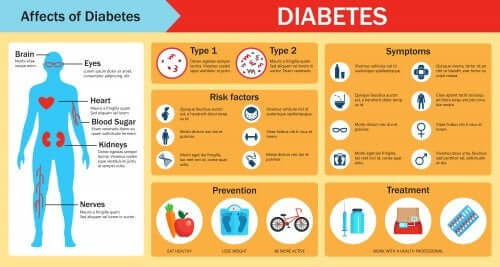How to Explain Diabetes to Children


Written and verified by the biologist Olga Carbajo
Finding a simpler and less traumatic way to explain diabetes to children presents a challenge, so any advice is more than welcome. Clinical psychologist Laura Fuster recommends addressing the issue as naturally as possible and following a series of steps to achieve it.
Diabetes is a chronic illness of unknown origin. It’s characterized by an increase of glucose in the blood, given a lack of secretion of the insulin hormone. Among the several types that exist, type I diabetes is the most common among the infant population.
Tips for explaining diabetes to children
Having a plan before addressing the issue without children is very important. It can mean the difference between the conversation flowing easily and it becoming an overcomplicated mess. Therefore, we hope you’ll find the following tips to be of use:
- Use clear and simple language that your children can understand. Be sure to adapt your wording according to age. It’s very important to use examples to illustrate your explanation.
- Reward children for the advances and achievements they make in regards to controlling their condition. This helps kids take on responsibility and, little by little, learn to take care of themselves.
- Work continuously each day to prove the autonomy your child is acquiring. This helps little ones feel that you trust in their abilities to deal with the disease.
- Children with diabetes need the tools to be able to explain their condition as naturally as possible in order to naturalize their condition. What’s more, it’s a good idea for parents to talk to their children’s teachers before this happens. That way, children have some positive reinforcement in the classroom.
Of course, we understand that this is all easier said than done. So, to help you explain diabetes to children, you can use the simplified version below. We hope, by offering this explanation, we can make these difficult times a little less complex for you and your little one.

Juvenile diabetes: A simple explanation for children
Following the advice of Doctor Fuster, we’ve looked for an analogy to help you explain diabetes to children using fun and familiar language. So, we suggest you imagine that your body is a car and that the different organs inside the body are the motor.
Diabetes is an illness that affects how our body uses its main fuel, sugar (glucose). When we fuel up – or eat – the part of our motor called the intestine is responsible for processing foods in such a way that the glucose in them reaches our blood.
Now is when the motor fails. At this point, it’s time for the gland called the pancreas to release the insulin hormone. This allows glucose to enter the insides of our cells and get to work. However, in people with type I diabetes, this doesn’t happen.
What is type I diabetes?
As we’ve said, the key to the gas tank of our cells is insulin. But in type I diabetes, the pancreas (that long, flat gland) either produces a different key that fits a different lock or forgets to produce it altogether.
As a result, the sugar doesn’t get into our cells, meaning their performance decreases. At the same time, glucose builds up in the blood. If its concentration becomes too high, then the consequences can be fatal.
To test the concentration of glucose in the blood (blood sugar level), we use a tool called a glucometer. This tells us how much glucose is in the blood, in case we need to correct it. It’s important not to lose sight of the fact that high blood sugar over long periods of time can produce the following:
- Vision, digestive, and kidney problems.
- Difficulty to control blood pressure and cholesterol.
- Depression.
- Irregular periods.

Therefore, it’s very important for children to be aware of their illness and learn to control it in a natural way. This means taking basic measures, including the following:
- Maintaining a healthy and balanced diet
- Doing sports
- If necessary, taking exogenous insulin
Recommendations for explaining diabetes to children
The association KidsHealth recommends seeing a doctor if you detect the following symptoms. That way, a pediatric endocrinologist can perform necessary tests:
- Urinating and drinking often.
- Weight loss for no apparent reason.
- Your child is very tired and doesn’t feel like playing.
As parents, we should be aware that how our children respond will depend greatly on how we ourselves face the situation. Therefore, we need to trust in our children’s ability to take on the responsibility of their diabetes. Since this is a chronic disease, it’s up to us to teach our children to be happy and autonomous individuals.
“The greatest gifts you can give your children are the roots of responsibility and the wings of independence.”
– Denis Waitley –
Finding a simpler and less traumatic way to explain diabetes to children presents a challenge, so any advice is more than welcome. Clinical psychologist Laura Fuster recommends addressing the issue as naturally as possible and following a series of steps to achieve it.
Diabetes is a chronic illness of unknown origin. It’s characterized by an increase of glucose in the blood, given a lack of secretion of the insulin hormone. Among the several types that exist, type I diabetes is the most common among the infant population.
Tips for explaining diabetes to children
Having a plan before addressing the issue without children is very important. It can mean the difference between the conversation flowing easily and it becoming an overcomplicated mess. Therefore, we hope you’ll find the following tips to be of use:
- Use clear and simple language that your children can understand. Be sure to adapt your wording according to age. It’s very important to use examples to illustrate your explanation.
- Reward children for the advances and achievements they make in regards to controlling their condition. This helps kids take on responsibility and, little by little, learn to take care of themselves.
- Work continuously each day to prove the autonomy your child is acquiring. This helps little ones feel that you trust in their abilities to deal with the disease.
- Children with diabetes need the tools to be able to explain their condition as naturally as possible in order to naturalize their condition. What’s more, it’s a good idea for parents to talk to their children’s teachers before this happens. That way, children have some positive reinforcement in the classroom.
Of course, we understand that this is all easier said than done. So, to help you explain diabetes to children, you can use the simplified version below. We hope, by offering this explanation, we can make these difficult times a little less complex for you and your little one.

Juvenile diabetes: A simple explanation for children
Following the advice of Doctor Fuster, we’ve looked for an analogy to help you explain diabetes to children using fun and familiar language. So, we suggest you imagine that your body is a car and that the different organs inside the body are the motor.
Diabetes is an illness that affects how our body uses its main fuel, sugar (glucose). When we fuel up – or eat – the part of our motor called the intestine is responsible for processing foods in such a way that the glucose in them reaches our blood.
Now is when the motor fails. At this point, it’s time for the gland called the pancreas to release the insulin hormone. This allows glucose to enter the insides of our cells and get to work. However, in people with type I diabetes, this doesn’t happen.
What is type I diabetes?
As we’ve said, the key to the gas tank of our cells is insulin. But in type I diabetes, the pancreas (that long, flat gland) either produces a different key that fits a different lock or forgets to produce it altogether.
As a result, the sugar doesn’t get into our cells, meaning their performance decreases. At the same time, glucose builds up in the blood. If its concentration becomes too high, then the consequences can be fatal.
To test the concentration of glucose in the blood (blood sugar level), we use a tool called a glucometer. This tells us how much glucose is in the blood, in case we need to correct it. It’s important not to lose sight of the fact that high blood sugar over long periods of time can produce the following:
- Vision, digestive, and kidney problems.
- Difficulty to control blood pressure and cholesterol.
- Depression.
- Irregular periods.

Therefore, it’s very important for children to be aware of their illness and learn to control it in a natural way. This means taking basic measures, including the following:
- Maintaining a healthy and balanced diet
- Doing sports
- If necessary, taking exogenous insulin
Recommendations for explaining diabetes to children
The association KidsHealth recommends seeing a doctor if you detect the following symptoms. That way, a pediatric endocrinologist can perform necessary tests:
- Urinating and drinking often.
- Weight loss for no apparent reason.
- Your child is very tired and doesn’t feel like playing.
As parents, we should be aware that how our children respond will depend greatly on how we ourselves face the situation. Therefore, we need to trust in our children’s ability to take on the responsibility of their diabetes. Since this is a chronic disease, it’s up to us to teach our children to be happy and autonomous individuals.
“The greatest gifts you can give your children are the roots of responsibility and the wings of independence.”
– Denis Waitley –
All cited sources were thoroughly reviewed by our team to ensure their quality, reliability, currency, and validity. The bibliography of this article was considered reliable and of academic or scientific accuracy.
- Bialo, S. (agosto 2018). Diabetes tipo 1, ¿qué es? [artículo en web especializada]. Recuperado de: www.kidshealth.org
- Wisse, B. (19 de agosto 2018). Complicaciones de la diabetes [artículo en revista científica]. Recuperado de: www.medlineplus.gov
- Canal diabetes (mayo 2013). Entrevista a la psicóloga clínica Laura Fuster [artículo en web]. Recuperado de: www.canaldiabetes.com
This text is provided for informational purposes only and does not replace consultation with a professional. If in doubt, consult your specialist.








